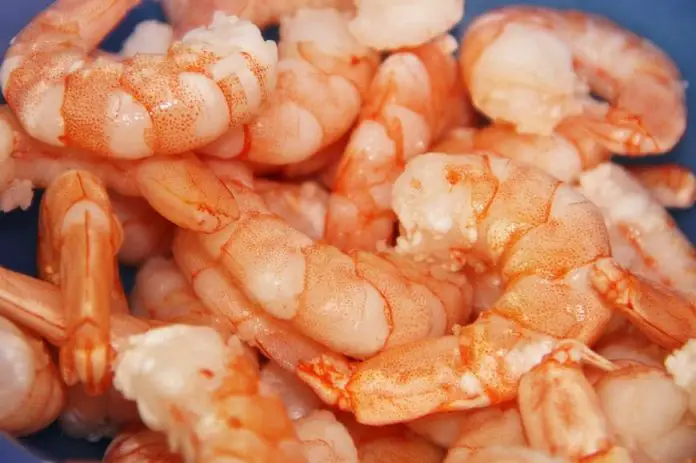When it comes to giving seafood to dogs, pet owners have conflicting opinions. There are some who share seafood with their dogs, believing that it is safe and healthy for their pets.
On the other hand, there are dog parents who are quite skeptical about offering seafood to their fur babies, thinking that it can do more harm than good.
Truth is, not all seafood is bad for dogs. Yes, there are types of seafood that you should avoid at all costs. This includes canned seafood with unhealthy amounts of additives and preservatives. But there is seafood that is good to go. Find out if shrimp is one of them.
Are shrimps safe for dogs? Is it true that they contain harmful toxins? Keep reading before offering shrimps to your dog.
Can Dogs Have Shrimps?
Yes, dogs can have shrimps. They are not toxic to dogs but you have to practice caution in offering them to your pet. Shrimps are safe for canines as long as they are cooked and are given in reasonable amounts.
When given in moderate amounts, shrimps can be a healthy treat for canines. Shrimps are a good source of essential nutrients for canines, including phosphorous, Vitamin B-12, and protein, which dogs normally get from consuming red meat.
Risks of Giving Shrimps to Dogs
Never give raw shrimps to dogs because it can be quite risky for them. Raw shrimps contain bacteria as well as parasites that can make the dog sick. Like most uncooked seafood, raw shrimps could leave your dog with gastroenteritis because of the microorganisms lurking in them.
A study by the Consumer Reports in 2015 revealed that 60% of raw shrimp is tainted with bacteria. The ponds where the shrimps came from were allegedly loaded with fecal matter as well as excess food and chemicals.
Other than this, you also have to consider the fact that certain dog breeds tend to have more digestive problems than others. While most dogs can easily digest shrimps, some dog breeds can have problems with it. Labrador Retrievers, Pomeranians, and German Shepherds are more prone to serious tummy troubles because of their sensitive stomachs.
There are several reasons why dogs develop gastro-enteritis and one of them is having a bacteria imbalance in their gut. If the dog suffers from intestinal upset after eating raw shrimps, it is best to consult your vet about it. Your vet may recommend giving the dog probiotics to reduce the upset tummy symptoms.
What Type of Shrimp Is Best For Dogs?
Wild-caught shrimps are believed to be a better option compared to farm-bred shrimps. When buying, it is important to look for certifications.
For wild-caught shrimp, it should be labeled with a certification from the Wild American Shrimp or the Marine Stewardship Council. Nowadays, you can easily find specialty stores selling wild-caught shrimp. They can also be found online.
Meanwhile, farm-raised shrimp isn’t really toxic to dogs but it may cause potential health problems because farmers use disinfectants and antibiotics.
The good news is that there are farm-bred shrimps raised without antibiotics. These products carry the Best Aquaculture Practices seal. Make it a habit to look for the seal of approval when buying shrimps not just for your dog, but especially for your own consumption.
Aside from the seal of approval from independent groups, you should also look for the freshwater varieties when buying shrimp. The best ones, according to shrimp experts, are the individually frozen and head-off varieties.
Benefits of Shrimps for Dogs
They are an excellent source of Vitamin B12, which plays an important role in a dog’s body. Without sufficient B12-vitamin, dogs could end up lethargic. This B-vitamin is essential for the normal growth of their cells. Like us, dogs also need enough of it on a daily basis so their nervous system functions well. This vitamin is often found in meat products. But if you wish to limit your pet’s meat intake, giving him shrimp as a healthier source of B-vitamin would not hurt. Four ounces of large steamed shrimp cover 78% of the Vitamin B12 requirement.
They boast an impressive amount of phosphorus. Another similarity of shrimp to red meat is that it contains a lot of phosphorus, with 347 mg for every 4-ounce serving. Another major nutrient found in shrimps, phosphorus is important for metabolizing the calcium in the body. The problem with most meat products is that they are high in phosphorus but low in calcium. Surprisingly, shrimp have enough calcium content with 45 mg for every 150-gram serving.
They are a lean source of protein. Did you know that shrimp are primarily rich in protein? Dogs thrive on a protein-rich diet but if you want to explore and try other protein-rich foods for Fido, there is nothing wrong with trying shrimps. They need protein as it helps in all aspects of growth and development. A 4-ounce serving of shrimp provides more than 26 grams of protein.
Shrimp are rich in selenium which serves as an antioxidant. Selenium works with Vitamin E as well as with certain enzymes in the body to protect the cells. Canines need a high-quality diet in order to meet their selenium requirement per day. For every four ounces of shrimp, dogs can get as much as 56 micrograms of selenium.
Shrimps are a low-fat and low-calorie treat. When your pet is on a diet, it helps to give him foods that are low in fats and calories. A medium shrimp only has around 7 calories. Aside from that, shrimps also have minimal amounts of carbohydrates.
They decrease the risks of colon cancer. One of the benefits of consuming shrimp is getting enough astaxanthin. This anti-inflammatory carotenoid nutrient is helpful in lowering the risks of cancer, especially in the colon area. Unknowingly to some, canines can also suffer from colon cancer. The worst part is that canine colon cancer has no known cure.
How to Give Shrimp to Dogs
Start by cleaning the shrimps. The easiest way to do this is by snipping through the shell right along the outer curve toward the tail using a pair of scissors. It’s a quick way to get rid of the vein as you rinse the shrimp under cold water.
Once the shrimps are all deveined, steam them for only around five minutes. Shrimps don’t need a lot of cooking time since heat can easily penetrate them. It’s not advisable to boil shrimps because they tend to be overcooked. Nobody likes overcooked shrimp because they are rubbery.
The best way to serve shrimps to dogs is by removing their shells and tails. Forget the spices and seasonings. For dogs, plain shrimp is enough because the seasonings could upset their stomachs.
Shrimp can be added to your dog’s usual treats. Put those chopped shrimps on top of your dog’s food or just sever it as is. Just make sure the shrimps were properly cooked before serving them to your beloved dog.
When Not To Give Shrimp to Dogs
Theoretically, canines could become allergic to seafood. If the pet has a history of hypersensitivity to shellfish, it is better to not offer him shrimps at all. Below are symptoms of seafood allergy to keep an eye on:
- Excessive scratching
- Itchy skin
- Hot spots
- Vomiting
- Diarrhea
- Runny eyes
- Sneezing
The proteins found in shrimp can trigger allergy not just in humans but also in dogs. With canines, their body might consider the protein as a foreign substance.
In the event that your dog reacts negatively to shrimp and presented symptoms like vomiting and suffering from diarrhea after eating it, there are only two possible reasons. First, there were bacteria in the shrimp probably because it was not stored or cooked properly. Second, it is also possible that the dog is experiencing allergy or hypersensitivity to the seafood itself.
If you noticed bright red blood in his stool, this means his colon is affected. This is due to the bacteria from the food he ate.
You could administer Famotidine, typically sold under the name Pepcid AC. This medication can help settle the dog’s stomach. The recommended dosage is only ½ of the 10 mg tablet for a dog weighing 10-20 lbs. It can be given every 12 hours.
Omeprazole is also a great option if you can’t give your dog Famotidine. It’s commonly sold under the name Prisolec. This can be given to canines to reduce the acid in their stomach.
The recommended dosage of Omeprazole for dogs is similar to that of Famotidine, ½ of the 10 mg tablet for every 10-20 lbs of body weight. However, it should be given every 24 hours.
In case none of these medications seem to help the dog after a couple of days, it is best to bring the dog to a veterinarian. The vet will conduct proper diagnostics to rule out if it’s really the shrimp that is making the dog sick or if it’s something else.
Conclusion
Shrimp is okay for dogs, as long as it is given in moderate amounts. It should only be given once in a while and not part of the pet’s regular diet. As always, it is best to tell your vet when you are giving shrimp to your dog for the first time. If you notice anything strange after feeding your shrimps, better stop giving them.
Also like to read:
Can Dogs Eat Sushi with Shrimp?






















